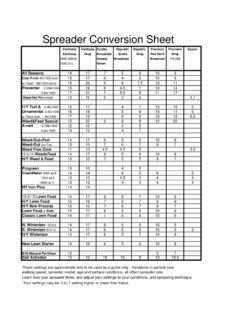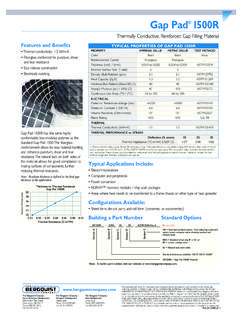Transcription of NEW YORK CITY DEPARTMENT OF …
1 NEW york city DEPARTMENT OF TRANSPORTATION. DIVISION OF BRIDGES. 2003 BRIDGES AND TUNNELS ANNUAL CONDITION REPORT. View from Manhattan of the Williamsburg Bridge August 2003 (Credit: Michele N. Vulcan). Michael R. Bloomberg, Mayor Iris Weinshall, Commissioner Judith E. Bergtraum, First Deputy Commissioner Henry D. Perahia, , Chief Bridge Officer Russell Holcomb, , Deputy Chief Engineer, Maintenance, Inspections & Operations Lawrence King, , Deputy Chief Engineer, Roadway Bridges Kamal Kishore, , Deputy Chief Engineer, Engineering Review & Support Albert P. Novak, , Deputy Chief Engineer, Specialty Engineering & Construction Jay Patel, , Deputy Chief Engineer, East River & Movable Bridges Diana Recor, Chief Staff Manager/Executive Director, Community Affairs Dorothy Roses, Executive Director, Management & Support Services Contents Commissioner's Message iii Section 1 2003 Executive Summary 1. Section 2 2003 Division Overview 4.
2 Section 3 2003 Chronology 11. Section 4 2003 Innovations and Accomplishments 60. Section 5 2003 Bridge Capital Program Appendix A 147. Section 6 2003 Flag Conditions Appendix B 163. Section 7 2003 Inventory Appendix C 168. Section 8 2003 Glossary of Bridges 212. Section 9 Components of the Preventive Maintenance Program 222. Section 10 Maintenance Personnel Resources 2003 vs 1900 231. Section 11 Bridge Inspection Equipment List 233. Section 12 2003 Motion Picture, Television, Video, and Still Photography Highlights 234. Section 13 Suggested Reading 236. Section 14 2003 Inventory Location Maps 243. ii 2003 BRIDGES AND TUNNELS ANNUAL CONDITION REPORT. A Message from the Commissioner On behalf of the many dedicated professionals who staff the Division of Bridges, it is my pleasure to distribute the 2003 Edition of the New york city DEPARTMENT of Transportation's Annual Bridges and Tunnels Condition Report, as mandated under New york city 's Charter.
3 The cover of this issue of the report marks the 100th anniversary of the opening of the Williamsburg Bridge on December 19, 1903. Designed by Leffert L. Buck, the bridge was the longest suspension bridge at the time of its completion and the first with towers entirely made of steel. A massive restoration project is near completion, and will make the bridge as vital for New Yorkers in the 21st century, as it was in the 20th. The release of this document provides the DEPARTMENT of Transportation with an opportunity to display the many achievements, innovations and improvements that were realized by the Division of Bridges during the 2003 calendar year. As a service organization, the DEPARTMENT of Transportation's Division of Bridges always aims to improve the quality of life for all New Yorkers and to minimize construction disruptions. The judicious use of Incentive/Disincentive clauses to accelerate construction programs, where appropriate, is just one example.
4 Preventive maintenance is essential in preserving the city 's multi-billion dollar investment in its bridges. These steel and concrete structures must be vigilantly protected from the stresses of the weather, traffic, deterioration and neglect. In accordance with the Division of Bridges' pro-active mission, 2003 was an important year for preventive maintenance. In-house repair crews eliminated 208 safety flag conditions that presented clear vehicle or pedestrian traffic hazards. Some 12,037 cubic yards of debris were removed, while 24,292 square feet of concrete were used to renew sidewalks, curbs, and road decks. Workers cleaned 1,549 bridge drains and, in the winter, sprayed 125,000 gallons of anti-icing chemicals on the East River bridges. In addition, crews eliminated 3,367,010 square feet of graffiti. The Division's proud tradition of design and engineering excellence was recognized with the receipt of awards from the New york Association of Consulting Engineers for the rehabilitation of the Queens Boulevard Bridge over Amtrak and LIRR Yard, as well as the reconstruction of the north roadways of the Williamsburg Bridge (Contract #7).
5 The New york city Art Commission selected the 153rd Street Bridge over Metro North project for an Award for Excellence in Design. In addition, in recognition of their commitment, dedication and outstanding work, Deputy Chief Engineer Kamal Kishore was presented the Outstanding Engineer of the Year award from Local 375, AFSCME, and Chief Bridge Officer Henry Perahia was presented the Municipal Engineer of the Year award from the Municipal Engineers of the city of New york . In 2003, the Division and its personnel proved, as always, equipped and ready to help the city prepare for major events including the Five Borough Bike Tour, the New york city Marathon, the West Indian Day Parade, the Thanksgiving Day Parade, and New Year's Eve in Times Square. New york city has a rich and conspicuous history of bridge design, construction, maintenance and administration. The DEPARTMENT of Transportation knows the importance of its duties and responsibilities, and the Division of Bridges is ever ready to shoulder the task of maintaining and rehabilitating our city 's vital bridge infrastructure.
6 Iii 2003 BRIDGES AND TUNNELS ANNUAL CONDITION REPORT. EXECUTIVE SUMMARY. Inventory In calendar year 2003, the inventory of bridges under the jurisdiction of the Division decreased from 755 to 753. This was not the only change to the inventory: the condition ratings of the bridges also changed. In fact, over the past 10 years, there has been a steady decline in the number of bridges rated Poor, and a somewhat steady increase in the number of bridges rated Very Good, as shown below. 1994 1995 1996* 1997 1998 1999 2000 2001 2002 2003. Poor 57 60 48 40 24 16 13 9 8 4. Fair 421 406 524 530 516 507 481 459 451 429. Good 321 342 148 145 154 160 180 196 202 209. Vgood 61 51 59 55 75 81 85 88 94 111. Unrated 68. 861 859 847 770 769 764 759 752 755 753. * In 1996, NYCDOT adopted a new rating scale to be used to determine the verbal condition of bridges. The new scale matches the rating scale by New york State DOT. The new scale changed the dividing line between Fair and Good bridges from to The net effect of this change was that, in 1996, 157 bridges that would have been rated Good were classified as Fair.
7 This accounts for the increase in Fair rated bridges and the decrease in Good rated bridges. Contract Acceleration Acceleration measures are a contract provision used in some reconstruction projects that is implemented through a contract pay item. This contract provision provides a mechanism to implement measures to accelerate the contractor's work to maintain critical path milestones. This provision does not apply to measures undertaken by the contractor to make up for time it lost in the progress schedule. Only the NYCDOT representative invokes this provision when the contract schedule is compromised due to unforeseen conditions during construction that are out of the contractor's control, and when it is deemed in the city 's interests to accelerate. Incentive and disincentive clauses are another contract provision used in some reconstruction projects that is implemented through a contract pay item. Under this provision, the contractor is compensated a certain amount of money for each day if the identified work in a critical milestone is completed ahead of schedule and is assessed a deduction for each day the contract overruns the allocated time.
8 The amounts for the I/D clauses are based upon such items as traffic safety, maintenance and road user delay costs, Resident Engineering & Inspection (REI) expenses and cost of traffic enforcement agents. These amounts are implemented in accordance with guidelines established by Federal Highway Administration (FHWA). 2003 was a year in which contract acceleration and the use of incentives/disincentives resulted in the early completion of several new bridge projects, such as: In March 2003, the Belt Parkway Bridge over Mill Basin contractor completed the emergency median guide rail installation and re-opened all lanes to traffic six days ahead of schedule. In June 2003, the North Upper Roadway of the Manhattan Bridge was re-opened to traffic 61. days ahead of schedule, thus earning the contractor a $3 million incentive. The reconstruction of the Grand Avenue Bridge over Conrail was substantially completed in November 2003, four months ahead of schedule.
9 1 2003 BRIDGES AND TUNNELS ANNUAL CONDITION REPORT. EXECUTIVE SUMMARY. Restorations In 2003, the Division completed the following restoration project: In May 2000, the ironworkers began installing a replica of a historic promenade railing on the Brooklyn-side walkway of the Brooklyn Bridge. The replacement of the deteriorated sections of promenade railing with replicas of the existing steel was completed in December 2003. East River Bridges Anti-Icing Program The Division's Anti-Icing Program uses the chemicals potassium acetate and magnesium chloride. The anti-icing fleet consists of fifteen spray trucks, ten plow trucks and several smaller plows. Six of the spray trucks are combination spray/plow trucks with an 1800 gallon tank capacity, and four are spray-spreader/plow trucks with a 900 gallon spray capacity, and a four cubic yard spreader capacity. There are a total fourteen chemical storage tanks, with a total storage capacity of 76,250 gallons.
10 In the winter of 2002-2003, a total of 125,000 gallons of anti-icing chemicals were applied on the roadways of all four East River Bridges. Waterway Study In 1999, the DEPARTMENT procured the services of an engineering firm to undertake a comprehensive study of the city 's 25 movable bridges. The surrounding areas, land use, maritime laws, regulations and other factors were considered to assist the DEPARTMENT of Transportation in providing justification to the Coast Guard for permission to either convert certain of these movable bridges to fixed structures, or to modify their status to reduce the number of bridge openings. Such conversions would save the city annual operation and maintenance costs. By the end of 2001, DOT advanced the waterway study to the point that we were able to identify those bridges that are suitable candidates for conversion to fixed status. Those bridges are the Borden Avenue and Hunters Point Avenue Bridges over Dutch Kills, the Grand Street Bridge over Newtown Creek, and the Bruckner Expressway over the Bronx River.












